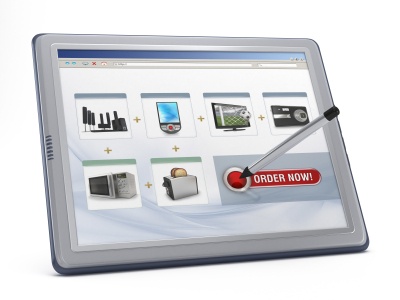

“Buy Me!” screams the red blouse with white stripes from shoulder to hip. You don’t remember how you found it, maybe you clicked on a pair of heels posted to social media; maybe you saw it on Pinterest. But for the duration of the time it takes you to add the item to your cart and check out, you are seduced into a purchase decision by a savvy team of sales and marketing professionals. How did they do it? To answer this question, we first have to understand what exactly it was that they “did.” At the highest level of thinking, the only one that shows up on analytics, they simply earned a conversion, but they earned that conversion by making the entire process seem less like a conversion at a point of sale and more like an experience you might have in a brick and mortar store.
Dynamic Price Fixing
One of the biggest algorithmic solutions that retailers are using to automate their marketplace is dynamic price fixing. Amazon has been using the dynamic price fixing technology for several years now -- items that are popular are increased (or, sometimes reduced) in price. This not only helps the company earn a bigger profit when more items are selling, but it also helps in supply chain management, managing supply and demand to keep a steady amount of each item flowing through the warehouse depending on how many items the company backstocks. Popular items like a Nintendo DS won’t see much price fluctuation - maybe a few pennies, at most. Unpopular items, like many grocery items, often see fluctuations in the $5-$8 range. Dynamic price fixing is, at the end of the day, just a mindless algorithm, which has created some interesting situations in the past. One writer reported several years ago that he had released an eBook on Amazon which was esoteric and targeted a very niche market. He didn’t sell any copies of the book, but a third-party seller’s bot had a better idea. They’d resell the same book for $0.50 more than the list price, even though there were no copies of the book in circulation. A few days later, another bot found the item, and undercut the first bot, actually selling the book for $0.50 less than the list price. If an individual had purchased the book from this bot, the bot owner would take a $0.50 loss on the sale. Over the next week, hundreds of bots found the book and began pricing it anywhere from $5 to $500, but since there was absolutely no interest for the product, no copies had yet sold. Amazon, seeing this flurry of bot-driven activity, raised the price of the writer’s book to about $400, or about 1,200% above its list price.

To start with, they probably used visualization technology to present digital imaging resources, but where online retailers used to only show photos, today’s online retailer has a plethora of other options. Clothing retailers are seeing widespread adoption of “Try It On” functionality, which allows a user to upload a photograph and display the item they are interested in buying directly on top of their image. And “Try It On” does exactly what it is supposed to do. Studies have shown in the past that hands-on shopping, or being able to pick up an item and hold it before making a purchasing decision, is crucial to getting more individuals to buy products, and even though Interactive Retailing is a relatively new field, studies published in the academic world in Retail and Fashion Management journals have highlighted the same propensity to “claim” items in this manner before we have actually bought them.
Electronic Product Catalogs
To use visualization technology to its fullest extent, it requires an extensive, easily-searchable electronic product catalog. With a combination of good Google optimization and an easy-to-use on-page navigation, many retailers have found that their product catalog is good enough for them. Others, like Amazon, have gone further, providing recommended suggestions for other products. It seems to work: NewEgg.com provides a social proof right on the product page, stating “43% of users who buy this item also buy this other item.” Amazon recommends three items that are “Frequently Bought Together.” Many sites utilize recommendation engines that help customers find products similar to those they have bought in the past. As an Interactive advertising professional, it’s easy to see these items as nothing more than secondary call-to-actions to increase conversions, but for your run-of-the-mill Internet user, these services are actually value-adds. With the expansion of the Internet into video (more than half of Internet traffic, now), many retailers are actually creating video product catalogs. By including a video, rather than an image, on product pages, users are able to see the product in action and watch a sales pitch much like they might on QVC. Smartphones are also creating opportunities to display interactive product catalogs. Car shopping iPad app CarZen allows users to sort automobiles by filters that matter - like gas mileage, price, or body style - then navigate through options via swipe gestures, ideal for for iPad users who have gotten used to this type of navigation. They can then view specifications, pictures, and even connect with one or more local dealerships and get quotes.

Mobile Technology Growth in Retail
Mobile phone use for shopping grew by 87% in 2011, but despite this rapid growth, about 1/3 of luxury brands still don’t support have a mobile-ready shopping process, which amounts to a huge mistake when one considers the types of individuals who typically log on from smartphones and tablets, often big-ticket buyers with large incomes. Among the sites that do support mobile usage, the largest concern for delivering large product images is mobile bandwidth, often only a tenth of the bandwidth available to a desktop or laptop computer. Retailers have found an innovative technology solution to solve this problem, using DHTML-tiled, interactive-zoom photographs and product images. These tiled product images can be loaded piecemeal as the user requires them. Additionally, they also show a “progression” of image loading from a few squares to the full image, and studies have shown that the longer it takes for users to see parts of your page, the lower their chance of conversion – up to 1% per 10ms of lag time, in some cases. By utilizing technology solutions to reduce the time it takes for users to purchase through mobile devices, the expected conversion rate of the page should increase.
Conversion Rate Optimization
Retailers are also using technology solutions like Google Analytics to drill down into conversion rates, asking questions like “Which of my products convert best?” or, perhaps more importantly, “Does this page/layout convert as well as this new page/layout?” Retailers use a technique called “split testing” -- also called A/B testing -- to determine which versions of copy and design are the most appealing to consumers. Retailers can take conversion optimization one step forward and actually optimize their entire sales funnel, answering questions like “Is the shopping cart and checkout process too long?” By developing several variations on the sales funnel, from entry to conversion, retailers can drastically improve their conversion rates. Even elements that some individuals might consider minor -- like the color or placement of the “Buy Now” or “Add to Cart” button -- can be the difference in abysmal and stellar conversion rates. 
Thoughts for Retailers Going Forward
Keeping in mind technology as it grows and changes is key to staying ahead of the retail curve. Many retailers are still lagging behind. In some cases, like failing to pre-load or load tiled product images, this reduces conversion rates. In other cases, like failing to create a mobile version of a site, it could completely prevent large segments of your population from purchasing on impulse.



